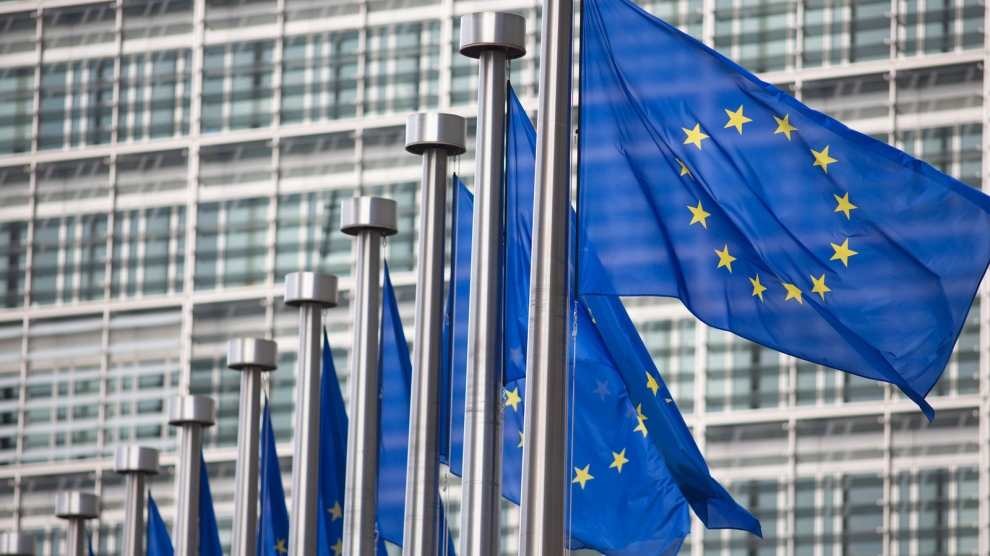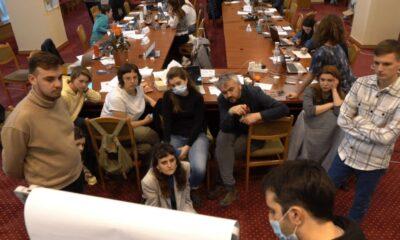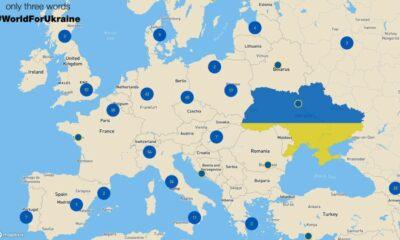Economy
Greek debt crisis affects Europe, world economy
Reading Time: 4 minutesAs Greece embarks on tough economic reforms it is facing the prospect of deep social unrest, with tens of thousands of workers taking to the streets this week. The Greek debt crisis is spilling over to other European economies – and threatening international prospects for economic recovery.
By Lisa Bryant
As Greece embarks on tough economic reforms it is facing the prospect of deep social unrest, with tens of thousands of workers taking to the streets this week. The Greek debt crisis is spilling over to other European economies – and threatening international prospects for economic recovery.
More strikes and social unrest. Tens of thousands of disgruntled workers spilled into Greek streets on Wednesday, registering their discontent with government austerity measures to control Greece’s spiraling public deficit and debt. Greece’s economic woes have posed the biggest challenge yet for the decade-old euro currency – and the 16 nations, including Greece, that make up the eurozone economy.
Greece has been a top subject in Brussels, where European Union leaders registered support for Athens and its economic reforms this month – but offered no financial assistance.
The Greek government has promised to slash its public deficit from nearly 13 percent of gross domestic product to nearly nine percent of Gross Domestic Product by the year’s end. Greece’s debt is currently estimated at more than $404 billion – or about 113 percent of its GDP.
Just how serious is the Greek crisis? Very serious, says economist Paula Subacchi of the Chatham House policy institute in London.
"The crisis is serious and it is serious for many reasons. One is because of the credibility of Greece. And the events of the past couple of days do not really improve confidence in the country and therefore foreign investors are very concerned," she said.
On Thursday, European Economic Commissioner Olli Rehn said he would personally inspect Greek’s austerity plans after receiving a report from EU, European bank and IMF auditors who were in Athens this week. Speaking to reporters, Rehn outlined some of the spillover effects of Greece’s problems.
"The mood deteriorated in some segments at the start of this year following growing concerns of the fiscal situation in some countries. This led to sharp increases in sovereign bond spreads in the euro area as we have seen recently – especially in the case of Greece," he said.
The European Commission – the EU’s executive arm – says it will be monitoring Greece carefully to see it lives up to its promises. Commissioner Rehn says the Greek crisis serves as a lesson for the eurozone as a whole.
Several credit tracking agencies have downrated Greece’s credit rating and Standard & Poor’s warned it could do so again. That could put Greece in the high risk investment category, making it very difficult for the country to borrow money.
Polls show that despite the social protests, the majority of Greeks support the government’s austerity measures. And Subacchi says it is critical Athens sticks to them.
"The Greek government has a huge problem. It needs first of all to regain credibility. And the way to do it is to make sure that the deficit reduction plan is credible. It’s not overambitious with the risk of triggering the kind of protest we’re seeing – but it’s not too mild," said Subacchi.
Analysts fault several factors for Greece’s debt crisis. The country overspent and failed to report the true size of its ballooning deficit to the European Union. Critics also say the European Union did not properly scrutinize the figures sent in by Athens.
But Simon Tilford, chief economist at the Center for European Reform in London, says the Greek crisis reflects a larger economic problem in Europe. EU members like the Netherlands and Germany have spent too little and their economies are driven by exports. Meanwhile, southern economies like Greece and Portugal have spent too much and amassed debts as a result.
"So in order to find a lasting solution, we need change on both sides. we need countries that have been hard hit in the south – such as Spain, Greece, Portugal, Italy – to take reforms to boost productivity growth, to cut costs, to manage their public sectors more efficiently," he said.
But Tilford says surplus countries like Germany have to provide more demand for southern European products.
Analysts fear Greece’s economic crisis risks spilling over to other southern European countries with shaky economies. It has also raised questions on complex and questionable financial deals between Athens and financial companies like Goldman Sachs. But Tilford says these are symptoms and not the root causes of Greece’s dilemma.
Analysts like Tilford and Subacchi believe European governments will ultimately come to Athens’s financial rescue – because a Greek crisis may soon become a European one.
"I’m personally very convinced there eventually will be a solution to the Greek problem. Because we cannot think what a default of Greece will trigger. It’s a risk nobody wants to take," said Subacchi.
Greece’s problems are also spilling beyond Europe’s borders. The value of the euro currency has plunged for example, which makes American exports – key to the U.S. economic recovery – less competitive.
Ultimately, Tilford says, the Greek problem reflects a world economic problem.
"The eurozone s really just a microcosm of the global problems we see. So unless we see the big countries in East Asia rebalancing away from exports and toward domestic demand, we are not going to generate a self-sustaining global economic recovery," he said.
But Tilford does not believe Europe is ready, or willing, yet to undertake fundamental economic reforms he thinks are needed to right these imbalances. The region may rescue Greece, he says, but it will only be putting a bandage on a far bigger problem.
Economy
Moldova will receive a disbursement of 36 million euros as part of the the Economic Recovery Plan

This week, the European Commission approved the disbursement of 36 million euros in grant money for the Republic of Moldova. The announcement was made by Deputy Director-General for Neighbourhood Policy and Enlargement Negotiations at the European Commission, Katarina Mathernova, who paid an official visit to the Republic of Moldova between September 13-15, together with Managing Director for Russia, Eastern Partnership, Central Asia, Regional cooperation and OSCE, at the European External Action Service, Michael Siebert.
The EU officials had meetings with President Maia Sandu, Minister of Foreign Affairs and European Integration, Nicu Popescu, Speaker of Parliament, Igor Grosu, Prime Minister of the country, Natalia Gavrilita, as well as key representatives of Government, international financial institutions and the civil society, according to a press release issued by the Delegation of the European Union to the Republic of Moldova.
Beside such topics as the EU-Moldova relations and prospects, the priorities of the reform agenda of the new Moldovan Government, preparations for the Eastern Partnership Summit at the end of the year and the Transnistrian conflict settlement, the officials also discussed the EU assistance in support of reforms and the Economic Recovery Plan for Moldova, which was announced in June with a total EU support of 600 million euros over the next 3 years.
“The first measures under the Economic Recovery Plan will shortly materialize, with the expected disbursement of 36 million euros in grant money under budget support programmes to support the authorities’ efforts to fight against the consequences of the pandemic. Moldova can count on EU’s assistance on its path to reforms and to recovery, bringing tangible results to citizens,” Katarina Mathernova stated.
The plan is based on assistance provided by the European Union through various bilateral and regional instruments, aiming to mobilize the funds in the form of grants, loans, guarantees and macro-financial assistance.
“The Economic Recovery Plan for the Republic of Moldova involves much more, not just this financial support provided immediately. It must help digital transformation, strengthen infrastructure, energy efficiency, education and support small and medium-sized enterprises,” the EU official also said.
As Prime Minister Natalia Gavrilita informed, “The Economic Recovery Plan and the 5 flagship initiatives for Moldova in the Eastern Partnership will directly contribute to the reform and consolidation of institutions, stimulate long-term socio-economic development, bring direct benefits to citizens, and unleash new economic opportunities through promoting the green agenda and digitization. Small and medium-sized enterprises (SMEs) have been hit hard by the crisis. Promoting and diversifying access to finance and reducing collateral requirements will be essential in supporting economic operators. We are grateful to the EU partners who will launch two programs to support 50 000 independent Moldovan SMEs to adapt to the new conditions.”
President of the Republic of Moldova, Maia Sandu, welcomed the decision of the European Union to disburse about 745 million lei in grant money, as the official page of the President’s Office announced. “EU support comes after a long period of freezing of European assistance, caused by former governments. We managed to relaunch the political dialogue with the European Union and resume financial assistance. The Republic of Moldova is gradually regaining the trust of its strategic partners. This European support is also a signal of encouragement for the new Government team in its commitment to clean up the institutions, fight corruption and launch development programs in the country,” said Maia Sandu.
Photo: unknown
Economy
Romania and Moldova signed a partnership memorandum pledging to cooperate in promoting their wines

The Chamber of Commerce and Industry of Romania (CCIR) and the National Office for Vine and Wine (NOVW) of the Republic of Moldova signed, last week, a memorandum of cooperation on organizing joint promotional activities in the markets of common interest, as the CCIR announced.
China, Japan or the USA are just some of the markets targeted by the Romanian and Moldovan institutions. The memorandum also involves advertising activities for wines from common indigenous varieties, promoting the oeno-tourist region, developing a tourist route in the two states, exchange of experience, study visits, and mutual support in identifying new export opportunities. “We are very confident that this collaboration between our organizations will lead to sustainable economic growth and a higher degree of well-being among Moldovans and Romanians,” claimed Deputy Secretary-General of CCIR, Bogdan Visan.
On the other hand, Director of the NOVW, Cristina Frolov, declared that no open competition with Romania is aimed at the governmental level of the Republic of Moldova. “This request for collaboration is a consequence of the partnership principle. Romania imports 10-12% of the wine it consumes, and we want to take more from this import quota. Every year, the Romanian market grows by approximately 2.8%, as it happened in 2020, and we are interested in taking a maximum share of this percentage of imported wines without entering into direct competition with the Romanian producer,” the Moldovan official said. She also mentioned that Moldova aims at increasing the market share of wine production by at least 50% compared to 2020, and the number of producers present on the Romanian market – by at least 40%.

Source: ccir.ro
**
According to the data of the Romanian National Trade Register Office, the total value of Romania-Moldova trade was 1.7 billion euros at the end of last year and over 805 million euros at the end of May 2021. In July 2021, there were 6 522 companies from the Republic of Moldova in Romania, with a total capital value of 45.9 million euros.
The data of Moldova’s National Office of Vine and Wine showed that, in the first 7 months of 2021, the total quantity of bottled wine was about 27 million litres (registering an increase of 10% as compared to the same period last year), with a value of more than one billion lei, which is 32% more than the same period last year. Moldovan wines were awarded 956 medals at 32 international competitions in 2020.
Photo: ccir.ro
Economy
Moldova’s hope to be a top walnut exporter and its main difficulties

The Republic of Moldova has perfect weather conditions for growing walnut trees, that creating a great potential of walnut production and trade, especially on international markets, where the demand is way higher than the product’s supply. National and international experts believe that the country’s walnut production industry is on the verge of important transformations, which could lead to increased yields, quality and competitiveness worldwide.
According to authorities, Moldova exports 34-35 thousand tons of walnuts in shell, which is about 7% of the total export of fruit and 5% of the total export of horticultural products. The export value is assessed as being $120 million, that being 57-60% of the total fruit export value and about 50% of horticultural export value. Most of walnut crops are exported to the EU countries, such as France, Germany, the Netherlands, Romania and Austria. The country’s exports were among the world’s top 10 when it comes to the highest dollar value of the product during 2020.
Viorel Gherciu, Minister of Agriculture and Food Industry, pointed out that the production in the domestic walnut industry has increased by 55% in the last five years, which ranks Moldova among the main producers in the world.
“The biggest opportunity for this industry is that we are in the geographical proximity of the largest walnut import area in the world, which is the European Union, with almost 40% of total imports in the world. We are on the EU border, with privileged relations, with an Association Agreement. We already enjoy a good relationship in working with European importers, they trust our processors. A very close collaboration has been created and this is, in fact, the guarantee for those who invest in the area,” claimed the president of the Walnut Producers Association, Oleg Tirsina.
The data provided by the National Bureau of Statistics show that there are 34.7 thousand hectares of walnut plantations in the country. 20.90 hectares are represented by orchards. 75% of planted orchards are formed of old varieties trees. 30-35% of the exported production comes from orchards, the rest comes from individual farmers and plantations along the roads. This means that the quality of walnut production is not at its maximum potential. Developing commercial plantations through orchards modernization and extension of walnut varieties would provide double yield and better quality, experts say.
Governmental support in the form of subsidizing solutions, foreign investments and credit options are indispensable for the industry development. One of the financing options is the credit line of the European Investment Bank Project. Since 2016, 15 producers and processors of nuts, almonds and hazelnuts have benefited from these loans with the total amount of investments worth 8.7 million euros. A further extension of the project would provide another 60 million euros for the modernization of the horticultural sector in general and for harvesting organic walnuts in particular.
Photo: heymoldova.com





















